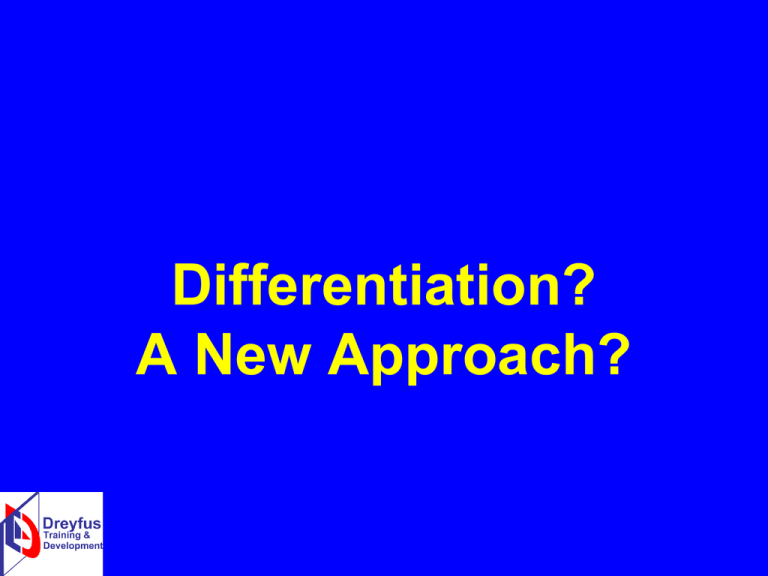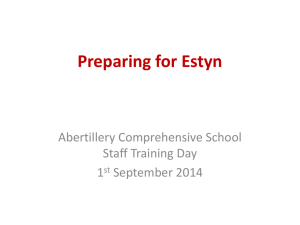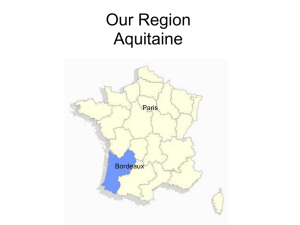Differentiation - Dreyfus Training and Development`s website
advertisement

Differentiation? A New Approach? Differentiation Where did it all go wrong? What is it? • the process by which differences between learners are accommodated so that all students in a group have the best possible chance of learning. Teaching Today: a practical guide, Geoff Petty Where did it go wrong? • One of the problems is that it has been interpreted to mean you treat students differently in the classroom, that you have low expectations of the weakest students and set them very simple tasks. The idea that every student should be taught in an individual way is a disaster; it doesn’t work. Geoff Petty The Past - What didn’t work? Whole School INSET ‘Differentiation’ • Limited time for a HUGE issue • Many teachers resistant: • Still not committed to taking responsibility for pupils with additional needs; • No real clarity about what this word means – approaches such as the Inclusion Development Programme suggest it’s about becoming ‘expert’ in all key areas of SEND – impossible from their starting points; • Already feeling overloaded – this means more work; • One-off session – even if they expressed some interest and motivation, inevitably, most never get round to doing something about it. A realistic model? • Step 1 • Focus on Quality First Teaching - a basic understanding of a range of strategies to meet the diversity of need likely in any mainstream classroom. • Step 2 • Provide meaningful/manageable information about pupils’ starting points and what this information means for teaching and learning. A realistic model? • Step 3 • Emphasise the need for differentiated learning outcomes • Step 4 • Ensure that differentiation by outcome does not result in failure for pupils with additional needs A realistic model? • Step 5 • Equip teachers with a range of simple strategies to enable match/personalisation/access for particular areas of need. (Check that they understand them) • Step 6 • Stop teacher reliance on teaching assistants to take responsibility for teaching individuals or groups in the classroom. A realistic model? • Step 7 • Stop colluding with and rewarding teachers who continue to avoid taking responsibility for the effective teaching and learning of pupils with individual needs. Materials and resources to support school development of Quality First Teaching for ALL The Pillars of Inclusion • These represent eight key aspects of planning and teaching that need to be in place to support the learning and achievement of pupils with SENDs. • They are derived from research and observations of good practice and cover aspects of practice over which all teachers have a significant degree of control. Subject Booklets • There is a short booklet outlining the Pillars of Inclusion. http://media.education.gov.uk/assets/files/pdf/n/the%20 pillars%20of%20inclusion.pdf • There are subject booklets for primary and secondary schools which consider the application of the pillars for all subject areas. http://webarchive.nationalarchives.gov.uk/201112180 81624/http://tda.gov.uk/teacher/developingcareer/sen-and-disability/sen-training-resources/oneyear-itt-programmes/subject-booklets.aspxre 1. Maintaining an inclusive learning environment • Consider: • Layout: seating allows all pupils to see/hear the teacher • Acoustics: background noise is reduced • Use of wall space: resources and displays are accessible and encourage independent use. 2. Multi-sensory approaches, including ICT • Consider: • Use of ICT • Use of a range of learning approaches, such as auditory, visual and kinaesthetic • Alternative communication e.g. diagrams, symbols • Alternative ways of recording 3. Working with additional adults • Consider: • Other adults as partners not teachers • Commitment to pupil independence • Joint planning and review 4. Managing peer relationships • Consider: • Flexible grouping • Buddying/peer tutoring • Circles of Friends 5. Adult-pupil communication • Consider: • • • • • • • Language used is positive and respectful Careful praise/correction Prepared questions for individuals/groups Use of preferred communication style Simplify the language of instruction. Break down instructions into manageable chunks Support verbal communication with facial expressions and simple gestures. • Give time to think. 6. Formative assessment/assessment for learning • Consider: • Choice of objectives/success criteria/peer assessment • Expectations/challenge • Communication issues 7. Motivation • Consider: • • • • • • • Engagement/enjoyment Rewards/praise Including pupil strengths/interests Relevant contexts Encouraging learning from mistakes Use of ICT for ‘fun’ ‘Can do’ ethos: readiness to ‘problem solve’ 8. Memory/Consolidation • Consider: • Developing the use of a range of memory aids • Helping pupils devise their own strategies for remembering Differentiation Pocketbook • Written by Peter Anstee, English Teacher. • Based upon giving pupils choice through a staged approach. • If students are given choice, they challenge themselves more than teachers do. • Very accessible, easy to use. • Can form the basis of introductory INSET sessions and on-going development activities. • Differentiation Pocketbook by Peter Anstee. £7.99 http://www.teacherspocketbooks.co.uk NASEN A Whole School Approach to Improving Access, Participation and achievement • A whole school training package for use in mainstream schools to give support, information and practical advice to ensure that the whole school community would have the basic knowledge and skills to support them in meeting the needs of all pupils. • A ‘toolkit training programme’ that is flexible and adaptable to meet the individual needs in each school. NASEN A Whole School Approach to Improving Access, Participation and achievement • Government Funded • Every SENCO in England had the opportunity to attend a free one-day event where toolkits were distributed and introduced. • NASEN Website has a webpage specifically for the project materials. • http://www.nasentraining.org.uk/ • The materials also include the Inclusion Development Plan materials for Autism, Dyslexia, BESD and SLCN. Priorities for Schools • • • • • • • Talk to SLT – engage their support and understanding for the need for development. NQTs – ‘catch them early’ – link to revised standards and completion of induction year. Link to appraisal and the revised standards for all staff. Work with the healthy parts of the system – identify colleagues who are interested and motivated and provide support – run pilot projects. Disseminate the outcomes of pilot projects across the whole school. Think about the most effective forms of CPD: INSET with follow up activities Lead teachers modelling/coaching Partnership teaching Lesson Study (http://www.advanced-training.org.uk/module1/M01U09.html) Work with teachers and teaching assistants. Where are you now? Where do you want to be in ? months? • Think about the issues discussed today. • Where are you now in your school in terms of effective teaching and learning for ALL pupils? Be honest! • What are your top 3 priority developments to improve practice and outcomes? • Set some target dates to achieve each of these priority developments.

![afl_mat[1]](http://s2.studylib.net/store/data/005387843_1-8371eaaba182de7da429cb4369cd28fc-300x300.png)






